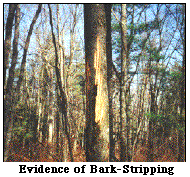Moose (Alces alces) are the largest members of the deer family. An adult male (bull) moose may be six feet tall at the shoulder and 900-1000 pounds in weight. An antler spread of over two 6 feet has been recorded. Most moose have a brownish coloration.
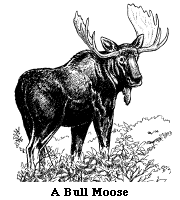 On the
Hackett Hill property, moose have been sighted in various "deeryards"
and near Hillcrest Terrace, a retirement community to the northwest
of the property.
On the
Hackett Hill property, moose have been sighted in various "deeryards"
and near Hillcrest Terrace, a retirement community to the northwest
of the property.
The antler growth and breeding and birthings seasons of a moose are similar to those of the white-tailed deer. Female moose (cows) aggressively defend their young calves from predators. The calves are reddish brown in color and unspotted. Although only 20-25 pounds at birth in the spring, they may weigh up to 3-400 pounds by fall.
Moose are primarily browsers, but in the fall, they begin feeding on the bark of some hardwoods. Moose, like deer, lack upper incisors and strip off bark with an upward movement of their lower incisors. Trees whose bark has served as food for moose can be readily identified by the markings. In warm months, moose feed on various types of water plants or wetlands plants, and probably locate near parts of the Hackett Hill property where this vegetation is available.
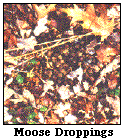
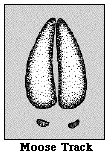 Moose droppings or "scat" are readily
identifiable by the size and shape of the pellets and indicate that a
moose has passed through a given part of the property. Moose hoof
prints are also easily identifiable. A typical print has two pointed
pear shapes with the tips closer than the wide bottom part. The track
is similar to a deer's, but twice as large (5-6").
Moose droppings or "scat" are readily
identifiable by the size and shape of the pellets and indicate that a
moose has passed through a given part of the property. Moose hoof
prints are also easily identifiable. A typical print has two pointed
pear shapes with the tips closer than the wide bottom part. The track
is similar to a deer's, but twice as large (5-6").
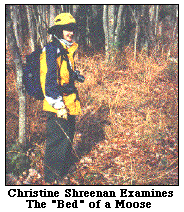 Christine Shreenan, while a student at the University of
New Hampshire at Manchester, performed independent studies on Hackett
Hill mammals. Her mentor for this work was Dr. Stephen Pugh, head of
the UNHM Biology Department.
Christine Shreenan, while a student at the University of
New Hampshire at Manchester, performed independent studies on Hackett
Hill mammals. Her mentor for this work was Dr. Stephen Pugh, head of
the UNHM Biology Department.
Christine's familiarity with moose
behavior patterns and signs of moose presence enabled her to "track"
the pathway a moose had recently made through a deeryard. In the
photograph shown here, she is examining a "moosebed" at the end of
one of these wanderings. In this open area, which is large enough to
accomodate the body of a prone moose, the vegetation was found to be
flattened and spread out - an indication that the animal had spent
the night at this spot.
Credits: The drawing of the moose appeared on the NH Fish and
Game Website. The drawing of the moose hoof print is from the British
Columbia Action Network.
PERTINENT LINKS
